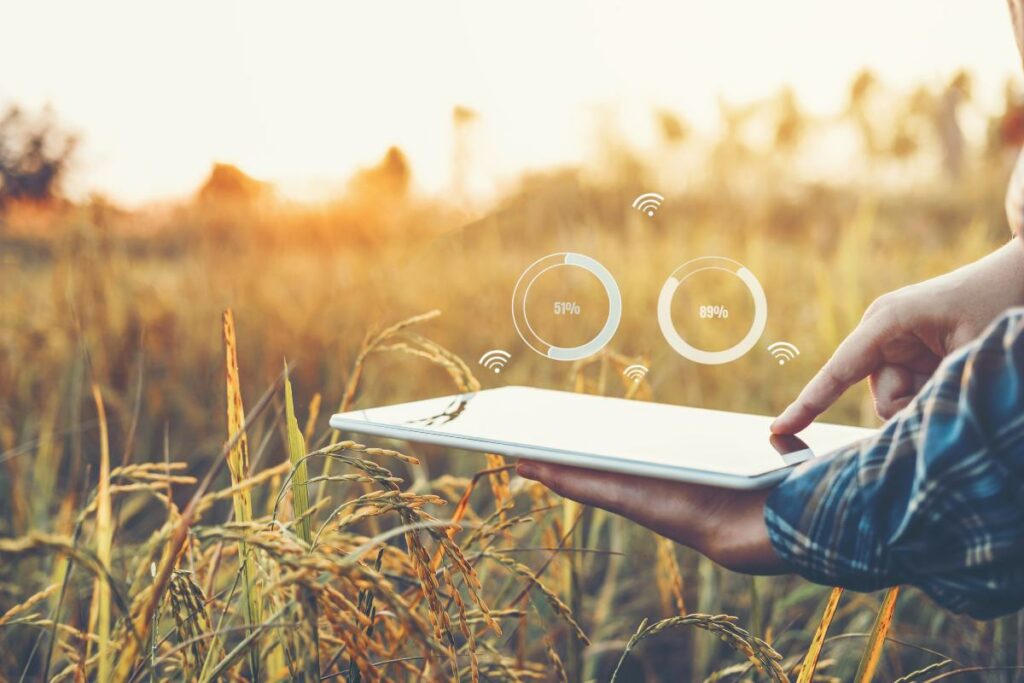Agricultural technology is constantly evolving and improving. New technologies are emerging that have the potential to revolutionize the agricultural industry. We will discuss some of the most promising emerging technologies in farming.

IoT Sensors
IoT sensors are becoming increasingly prevalent in the agricultural industry. These sensors can collect data about conditions in the field, such as temperature, humidity, soil moisture, etc. This data can be used to optimize irrigation and fertilization schedules and predict crop yields.
These sensors can also be used to monitor livestock. IoT-connected sensors can track the health and location of animals, as well as their feed and water consumption. This information can be used to improve animal husbandry practices.
Precision Agriculture
Precision agriculture is a term that encompasses a variety of technologies, including GPS, yield mapping, and variable rate application. These technologies allow farmers to optimize their inputs (fertilizer, water, seed, etc.) based on the specific characteristics of their fields. Precision agriculture can lead to increased yields and reduced input costs.
Robotic Automation
Robotic automation is another promising technology being implemented in the agricultural industry. Robotics can be used for tasks such as crop picking and sorting and livestock herding. This technology can improve efficiency and accuracy while also reducing labor costs.
Drones
Drones are used in various agricultural applications, including crop mapping, precision farming, and livestock management. Drones can be equipped with sensors and cameras to collect data about crops and fields. This information can be used to optimize irrigation and fertilization schedules. Drones can also be used to herd livestock.
Blockchain
Blockchain is a distributed database technology explored for various use cases in the agricultural industry. Blockchain could be used to track the provenance of food products and facilitate transactions between farmers and buyers. This technology can potentially increase transparency and efficiency in the agricultural industry.
Autonomous Vehicles
Autonomous vehicles are beginning to be used in agriculture for crop scouting and soil sampling. These vehicles can quickly and accurately cover large areas and reduce labor costs associated with these tasks. They also have the potential to be used for functions such as livestock herding and crop picking in the future.
AI/ML
Artificial intelligence (AI) and machine learning (ML) are used in agriculture for yield prediction, pest detection, and crop classification. AI/ML-based systems can analyze large data sets to identify patterns and trends that can be used to improve Agricultural productivity.
Data Analytics
Data analytics collects data about crops, soil, weather, and market conditions. This data can be used to improve agricultural production practices, optimize crop yields, and make better decisions about pricing and marketing strategies.
How To Implement These Technologies
The best way to implement these emerging technologies will vary depending on the specific application. However, there are a few general considerations that should be made.
First, it is essential to ensure that the data collected by IoT sensors and other devices are properly managed and stored. This data can be used to improve agricultural production practices, but it can also be used to enhance marketing and pricing strategies. Second, it is essential to understand the costs associated with implementing these technologies. Some of these technologies, such as precision agriculture, can be expensive to implement. Others, such as drones, may require special permits or licenses.
Finally, partnering with a trusted provider of these technologies is essential. This will ensure you can get the most out of these technologies and implement them effectively.
When To Implement These Technologies
The timing of when to implement these technologies will vary depending on the specific application. However, in general, it is essential to implement these technologies when they can provide the most benefit. For example, precision agriculture should be implemented before planting to ensure that inputs are correctly applied. Drones can be used throughout the growing season to monitor crops and collect data.
Blockchain can be used to track the provenance of food products from farm to table. Autonomous vehicles can be used for crop scouting and soil sampling. AI/ML can be used for yield prediction, pest detection, and crop classification. Data analytics can be used to improve agricultural production practices, optimize crop yields, and make better decisions about pricing and marketing strategies.
Financing
There are several ways to finance the implementation of these technologies. Government grants and subsidies can offset the costs of precision agriculture, drones, and autonomous vehicles. Low-interest loans can finance the purchase of IoT sensors and other equipment. Private investment can also be used to fund the adoption of these technologies.
Emerging technologies are beginning to be used in agriculture for precision farming, crop scouting, and yield prediction. These technologies have the potential to improve agricultural productivity and efficiency. However, it is essential to consider the costs and benefits of implementing these technologies.




